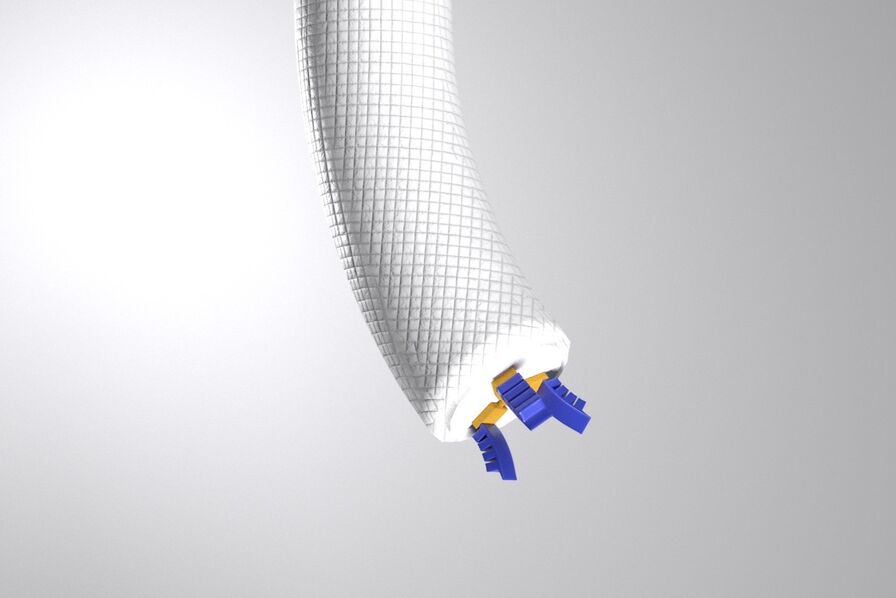Flexible robots on the road to industrial applications
Date:
Changed on 22/10/2024

In the collective imagination, a factory robot is a rigid, articulated arm that moves objects with inhuman stiffness. This view is still true today, but other avenues are being explored in parallel research and development. New work in robotics is focusing on more flexible materials, better suited to transporting delicate objects or in narrow spaces. This is precisely the field of activity of Compliance Robotics, a start-up from Inria's Defrost project team (working jointly with the CRIStAL laboratory, University of Lille and Centrale Lille).
Verbatim
Our company was born out of a research project that evolved into concrete applications. Our idea was to transform the way robots are designed, particularly in industry.
Auteur
Poste
Founder of Compliance Robotics and Inria research director
The team's aim is not to rely solely on these robots, which rely on joints for most of their movement, but to draw inspiration from what is found in nature, such as invertebrates, which can move without all that rigid bone structure. Here, the machines are built from polymers, silicone and plastic, sometimes with instruments made by 3D printers. The aim is to obtain materials that can deform, be elastic and resist over the long term.
We wanted to take inspiration from what is sometimes done in medicine,’ explains Christian Duriez. In research, the main application targeted by these flexible manipulators is surgery, to be able to navigate safely through the anatomy. But we believe that this technology could also be of interest to industrial robotics.
Prior to its official creation in February 2024, Compliance Robotics was initially supported by the Start-Airr scheme for a year and a half, then by Inria Startup Studio over the course of a year; an essential first stage of modelling research to determine the needs of these potential flexible robots. Will they be able to meet the standards expected by industry? What types of materials or sensors will they need? And above all, will they really be useful?
During this phase, the team also received support from the Hauts-de-France region and Bpifrance. And on 19 September, its efforts paid off: the young start-up was awarded a Grand Prize in the i-Lab innovation competition (organised by the French government and run on its behalf by Bpifrance), along with €500,000 in funding. Enough to finance around 60% of future R&D. All of which adds credibility to the project and opens the door to more ambitious fund-raising in the future.
In the meantime, Compliance Robotics has already developed an initial prototype called Emio. Its parallel structure with four flexible rods is 3D printed, and a flexible gripper can be placed at their end.
The main aim of this first robot is educational. The prototype is being used in engineering schools to train students in this field.
Verbatim
It's quite a playful structure. You can change the architecture to suit your needs, print new rods in 3D, and manipulate it in different ways. It makes lessons a lot more fun!
Auteur
What's more, these educational experiments are filmed using a 3D camera system so that the prototype can be improved.
At the same time, the team is developing other models aimed at the food industry. The Hollow robot is equipped with a conveyor system in which objects can travel through a flexible tube. The aim is to move fragile objects such as fruit and vegetables at high speed. These delicate products can thus be transported without the risk of being damaged in the process.
On an industrial scale, for robots to move faster, their movements have to be quicker, which is risky for the most fragile items,’ points out Christian Duriez. Here, Hollow can move fruit or vegetables from point A to point B without any apparent movement, at least as seen from the outside. These products go in on one side of the tube and come out on the other, which is faster and safer.
In addition, this hollow structure proves particularly practical for conveying materials such as glue or paint, which could pass directly into the tube without having to pierce it from the outside.
Compliance Robotics' ambition? To sell this robot to industrial groups in the near future. However, the current model is not yet sufficiently mature. Christian Duriez is hoping for a first market launch from 2027. To achieve this, the start-up can also count on the support of Inria.
Verbatim
We still have one foot in the Inria research laboratory. And we are in the process of comparing our theoretical work with these practical applications. Robots are becoming increasingly complex, and simulations sometimes show their limits. The back and forth between the scientific and industrial worlds is therefore very useful.
Auteur
In this way, application work on robots provides researchers with data, enabling them to improve their models, which in turn help to perfect certain aspects of the robots.
One of the priority areas for research is how to control these robots, to ensure that they cannot become dangerous. Because with their flexibility comes greater complexity. We need to be able not only to predict how they will move, but also to anticipate how they will deform under certain constraints, which requires advanced algorithmic research. Compliance Robotics is conducting this work through the SOFA consortium, an open source software platform for simulations (hosted by the Inria Foundation).
Last but not least: sustainability. The start-up is looking to produce future Emio and Hollow robots that consume less energy. Then, as Quentin Peyron, an Inria researcher in the Defrost team, suggests, less processed or more durable materials, such as wicker or bamboo, will be favoured to ensure a bright future for these flexible robots.